Top hr & hiring statistics in tech for 2021

The uncertain circumstances that surfaced in 2020 had great ramifications on job markets around the globe. No more so dramatic than in tech. For a lot of recruiters, it’s reasonable to wonder: what happens to all of the talent that’s being laid off?
For more recent statistics check out, 76 hiring & hr statistics in tech for 2023
As we do every year, we have run the events of the past year under the microscope to reveal 2020s recruitment trends in our annual 2021 HR statistics summary. To help you sift through the numbers, we’ve put together a list of over 60 powerful hiring and job statistics for 2020. The numbers have been crunched by the likes of, iCIMS, LinkedIn, Glassdoor, Jobvite, Stack Overflow, Robert Half, Manpower Group, Monster, and the Bureau of Labor Statistics.
The recession brought about by the pandemic led to companies acting more conservatively with their budgets. Many were having to cope by reducing employee numbers or completely stopping looking for new hires, and research by UK job board CV-Library found that 64.7% of IT professionals are worried about losing their job during the coronavirus pandemic.
In 2020, there was a common theme of a drop-off in job searches and loads of salary cuts, but also some silver linings in these turbulent times. Sales and marketing positions have had to tough it out — particularly at consumer-facing startups.
But individuals have also reacted to this uncertainty in positive ways – TechUK found that 58% of people want to work on developing their digital skills, and some believe the industry must be swift to capitalize on this.
With the ever-changing landscape of tech, none more so relevant than the present day, considering these latest trends can help improve your hiring strategy to help you attract the right candidates.
Source: Unsplash
- Job Search HR statistics
- Talent shortage HR statistics
- Resume statistics
- Job interview statistics
- Sourcing statistics
- Diversity statistics
- Candidate experience statistics
- Employer branding statistics
- Salary statistics
- Top skills statistics
- Developer HR statistics
- Employee satisfaction statistics
- Covid-19 impact statistics
- 2021 HR Statistics key takeaways
- Job Search HR statistics
- Talent shortage HR statistics
- Resume statistics
- Job interview statistics
- Sourcing statistics
- Diversity statistics
- Candidate experience statistics
- Employer branding statistics
- Salary statistics
- Top skills statistics
- Developer HR statistics
- Employee satisfaction statistics
- Covid-19 impact statistics
- 2021 HR Statistics key takeaways
Job Search HR statistics
- The latest data from the Bureau of Labor Statistics found that people out of work in 2020 were most likely to find a job in either about one month or after more than six months. In December 2020, 27% of job seekers were unemployed for less than five weeks, while almost 37% of people were unemployed for 27 weeks or more.
- There were 18% fewer job applications from 35-44-year-olds in October 2020 compared to October 2019. There were 17% fewer applications from the 25-34-year-old age group. This indicates that professionals are avoiding risk in changing jobs in the current environment. (iCIMS)
- Research from the Federal Reserve Bank of Boston has found that after U.S. workers are out of work for more than six months, it gets harder for them to get out of unemployment.
- According to the latest Stack Overflow Developer Survey 2020, which surveyed 65,000 developers around the world, only 3.7% of developers are currently unemployed and looking for a job.
- On average, 10% of job applications result in interview invites. Out of those who land the interview, 20% are offered the job. Depending on the study, the job application success rate is between 2% and 3.4%. This means that, on average, you need to send between 30 and 50 resumes to get hired. (Zety)

Source: BLS
Talent shortage HR statistics
- As of October 2020, the national unemployment rate for 2020 is 6.9%. The year started with an unemployment rate of 3.6% in January. After March, the rate rose until it peaked at 14.7% in April. Since then, it started its decline (at a slower pace) and reached 6.9% in October. This is almost double the unemployment rate of October 2019 (3.6%). (Bureau of Labor Statistics)
- There are 2.5 people per job opening (as of September 2020). This number is lower compared to the 4.6 ratio in April, but very far from the pre-pandemic one. Since March 2018, the number of job openings has exceeded the level of unemployment. (Bureau of Labor Statistics)
- 54% of recruiters offer additional training and development to overcome talent shortages. If they can’t find candidates with the needed skills, they train them for the job. (Manpower Group)
- A third of candidates expect employers to step up and train workers versus just 19% of employers who said they should be responsible. (Monster)
- Globally, 54% of companies say that they are experiencing a talent shortage. Talent shortages are increasing around the world, with the greatest year-over-year increases in the U.S., Sweden, Finland, Hungary, and Slovenia. Only 18% of countries are not reporting talent shortages. (Manpower)

Source: Manpower Group
Resume statistics
- 77% of employers say seasoned workers should NOT use a single-page resume. (Zety)
- Data shows that recruiters are 2.9x more likely to pick a candidate with a two-page resume for managerial roles and 1.4x more likely for entry-level positions. (Zety)
- The most effective job-hunting strategy is to customize each resume to match the requirements from the job ad (63% of recruiters want to receive resumes tailored to the open position). (Zety)
- Only 3% of candidate resumes score above the minimum score requirement for many companies’ internal ATS (Applicant tracking system, a tool that scans resumes for specific keywords to determine if they’re worth passing on to a recruiter). Around 7% of resumes score between 60% and 85%, and 50% score between 30% and 59%. (Resumeble)
- Job applicants with an extensive LinkedIn profile were 71% more likely to get a callback for a job interview than candidates without any LinkedIn profile. (Statista)

Source: Zety
Job interview statistics
- As a result of the pandemic, 84% of recruiters have resorted to phone interviews, while 85% of them to video interviews. (Lever State of Recruiting Report)
- While the percentage of applicants to interviews barely changes depending on the organization size, the interview-to-job-offer ratio is highest in companies with 5,000+ employees. 41% of candidates interviewed by the largest organizations receive a job offer (20% in companies with less than 500 employees). (Jobvite)
- With the shift to remote work and the decline of in-person activities, virtual recruiting became essential during the pandemic. 70% of U.S. recruiters used virtual technology for at least half of their candidate interviewing and new-hire onboarding, while another 35% said that at least 75 percent of their recruiting practices were virtual. (Monster)
- The three recruiting challenges anticipated for 2021: (Monster)
- Assessing candidates during the interview (41%)
- Identifying quality candidates quickly (40%)
- Effectively screening candidates pre-interview (36%)
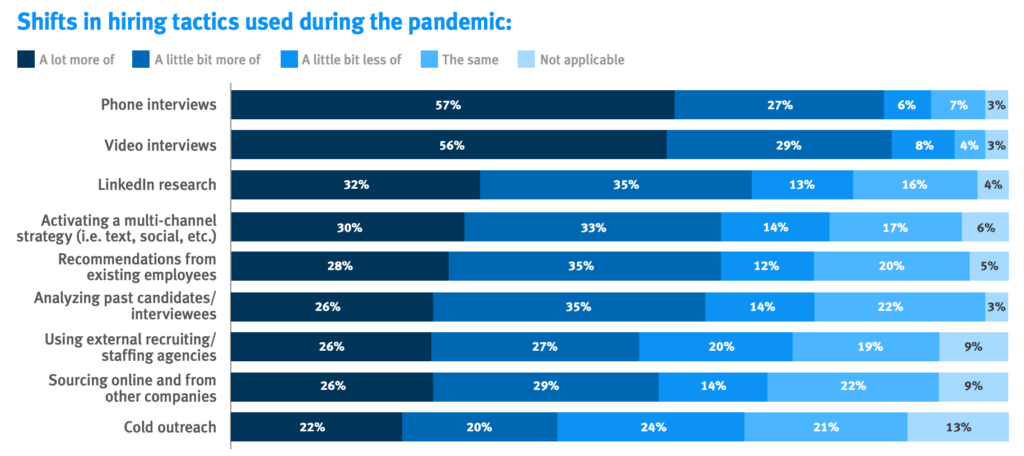
Source: Lever
Sourcing statistics
- Almost 50% of all applications come from job boards, followed by internal career sites (35%). But less than 1% of candidates who apply for jobs through job boards and career sites are offered the position. (Jobvite)
- The most effective way to apply for jobs, in turn? Directly to the hiring manager! Out of all candidates who apply this way, 19% land the job. (Jobvite)
- Depending on the source, between 70% (Forbes) and 85% (LinkedIn) of jobs are not posted online at all—these positions are filled via networking and internal referrals.
- At the same time, more than half of job seekers say their preferred source for finding jobs is online. The second most popular method is hearing about it from a friend, preferred by 45% of candidates. (Glassdoor)
- 94% of recruiters already use or plan to use some form of social recruitment. 70% say they will increase their investment in social recruiting. (CompareCamp)
- 81% of talent professionals agree that virtual recruiting will continue post-Covid. (LinkedIn)
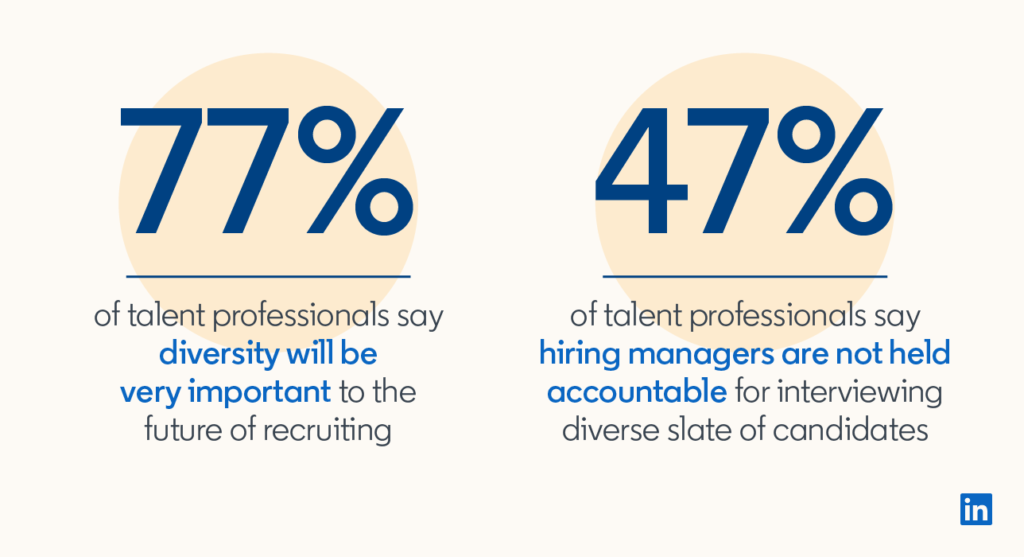
Source: LinkedIn
Diversity statistics
- Only 9.5% of people in the US consider the diversity of the company or organization as an important job factor. 18.6% for women, and 5.5% for men (Stack Overflow)
- 77% of talent professionals say diversity will be very important to the future of recruiting. 47% of talent professionals say that hiring managers are not held accountable for interviewing a diverse slate of candidates. (LinkedIn)
- Remote jobs result in over 20% more geographical diversity among applicants. (LinkedIn)
- Diversity and inclusion was considered the second-fastest growing skill in 2020, with 42% of recruiters agreeing. (LinkedIn)
- Companies in the top tier for racially and culturally diverse executive teams were 33% more likely to experience above-average profitability than companies in the bottom tier. (McKinsey)
- Although the majority of U.S. employers (56%) say that they are updating their recruitment strategies to attract more diverse talent, 30% of employers revealed they don’t have a DEI strategy in place. (Monster)
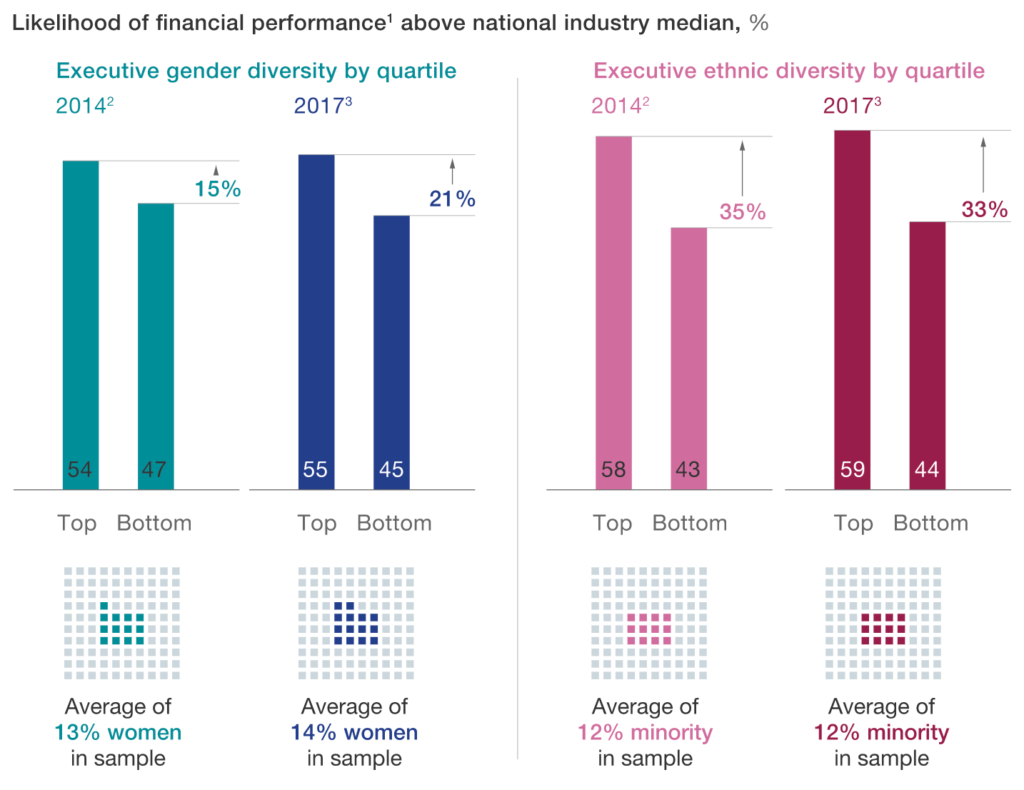
Source: McKinsey
Candidate experience statistics
- 63% of professionals realize that their job is doable from home. (Robert Half)
- 97% of workers say that their manager has been a source of support during this challenging time. (Robert Half)
- 46% of workers want their employer to change their office layout in an effort to maintain social distancing. (Robert Half)
- Some parts of applying for a job are more important than others. The aspects that job seekers find most important to a positive experience include clear and regular communication (58%), clear expectations (53%), and feedback regarding rejection (51%). (Glassdoor)
- On average, mobile-device applicants complete 53% fewer applications than desktop applicants, which may indicate that many job postings are, in fact, not mobile-friendly. (Glassdoor)
- 96% of professional employers say the candidates’ experience is becoming more important. Yet, only 52% of companies say they provide a positive employee experience. (LinkedIn)

Source: Robert Half
Employer branding statistics
- 63% of talent professionals expect their employer branding budget to increase or stay the same. (LinkedIn)
- 75% of active job seekers are likely to apply to a job if the employer actively manages its employer brand (e.g. responds to reviews, updates their profile, shares updates on the culture and work environment). (Glassdoor)
- 44% of developers said that company culture is a leading consideration for them when choosing to apply to a company (Stack Overflow)
- Your employer brand will hinge on empathy and actions. Engagement uplift increased by 84% on company posts when the topic included diversity. (LinkedIn)
- Almost 50% of recruiters say that social media will be their #1 investment when it comes to building an employer brand and sourcing candidates. (Jobvite)

Source: LinkedIn
Salary statistics
- Across the board, engineering managers ($92,000), SREs ($80,000), DevOps specialists ($68,000), and data engineers ($65,000) tend to receive the highest salaries. When focusing on the US, we see some differences at the bottom of the salary spectrum. In the US, mobile developers and educators tend to have a higher salary relative to other occupations when compared to the global developer population. (Stack Overflow)
- Recruiters estimate they will pay entry-level employees an average of $56,532 in 2020 and 2021—a jump of over $10,000 compared to 2018. (iCIMS)
- Boosting pay won’t boost the number of applications as much as a positive company culture. Having a 1-star higher overall rating on Glassdoor — a score that includes points for positive company culture — attracts talent at about six times the rate of paying a $10,000 per year higher salary. (Glassdoor)
Top skills statistics
- 73% of companies say people analytics will be a major priority for the next five years. 55 percent of companies say they still need help with basic people analytics. (LinkedIn)
- 242% increase in HR and hiring professionals with data analysis skills listed on LinkedIn over the last five years. (LinkedIn)
- The fastest-growing skill for recruiters is personal development (44%) — the ability to add new skills. (LinkedIn)
- Security professionals (cloud, data, information, network and systems), network architects and database administrators are the roles with the lowest unemployment rates, highlighting their position as the most in demand in the 3rd quarter of 2020. (Robert Half)
- 55% of employers feel that the existing skill gap in organizations is an impediment to innovation. (PwC)
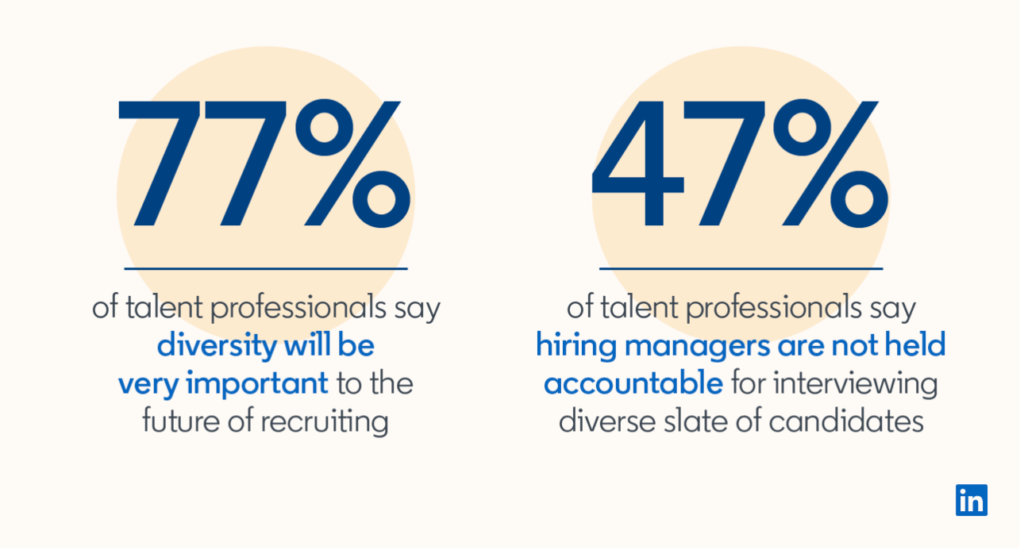
Source: LinkedIn
Developer HR statistics
- In 2020, the cloud services industry generated almost $40 billion in revenue, taking its market value to a total of $266.4 billion from the $227.8 billion in 2019, an 17% growth in just one year. (Social Hire)
- There has been a 43.9% year-on-year drop in advertised tech roles in July 2020, but there are certain roles firms are still looking for, such as in cloud, data science and artificial intelligence (AI), but are struggling to fill due to pre-existing talent gaps. (CV-Library)
- The median salary for a software developer is currently $103,620 while the unemployment rate is only 1.4%. The low unemployment rate (1.6%) and expected growth (26% by 2028) means companies will be hiring for years to come. (US News)
- In 2021, TensorFlow (70%) and PyTorch (65%) will be the “go-to” library for Enterprises and communities with their big increase in popularity. Overall, .NET Core (71%) is the most loved web framework by developers. (Stack Overflow)
- In April 2020 there was an average of 22.57 applications for each tech role advertised, an increase from 9.62 in April 2019 – meaning these roles will likely go to more skilled candidates rather than new entrants to the market. (Computer Weekly)
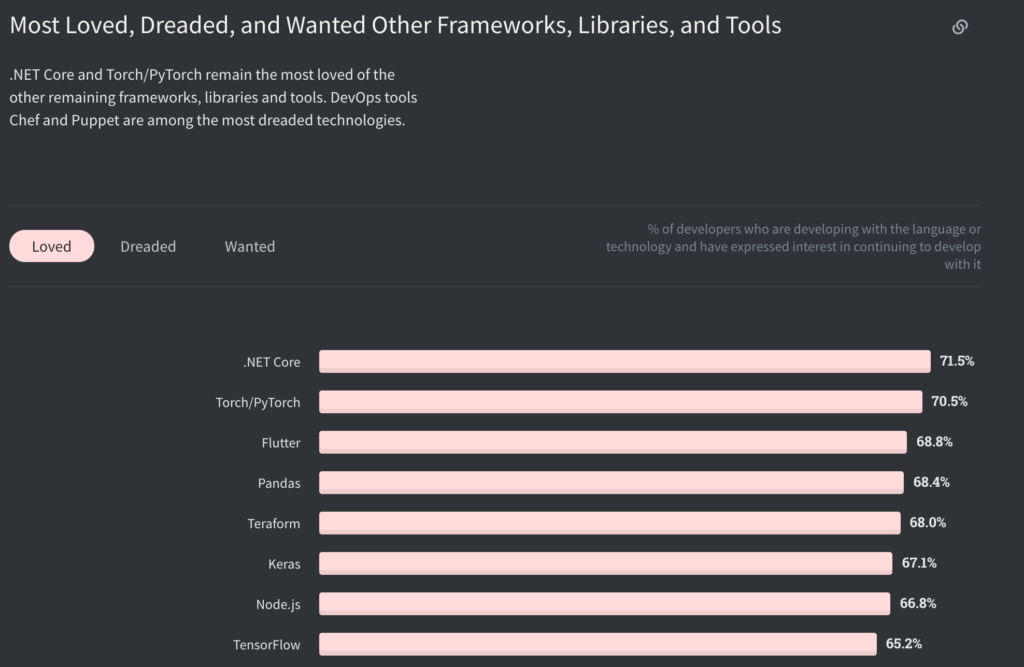
Source: Stack Overflow
Employee satisfaction statistics
- Overall, developers tend to be satisfied with their jobs, with almost 65% reporting that they are either slightly or very satisfied with their job. On the other end of the spectrum, around 25% are slightly to very dissatisfied. (Stack Overflow)
- 79% of employees who are offered free training like their jobs versus only 61% who are not offered training. (ManpowerGroup)
- 49% of workers globally have had their skills assessed by an ATS. 81% of those who have been assessed report higher job satisfaction versus 65% of those who have not. (ManpowerGroup)
- Employees whose manager listens to their work-related problems are 62% less likely to burn out. (Fast Company)
- While American workers in general are largely satisfied with their current jobs (63% in April, 66% in February), about half are open to other job opportunities (48% in April, 51% in February). (Jobvite)
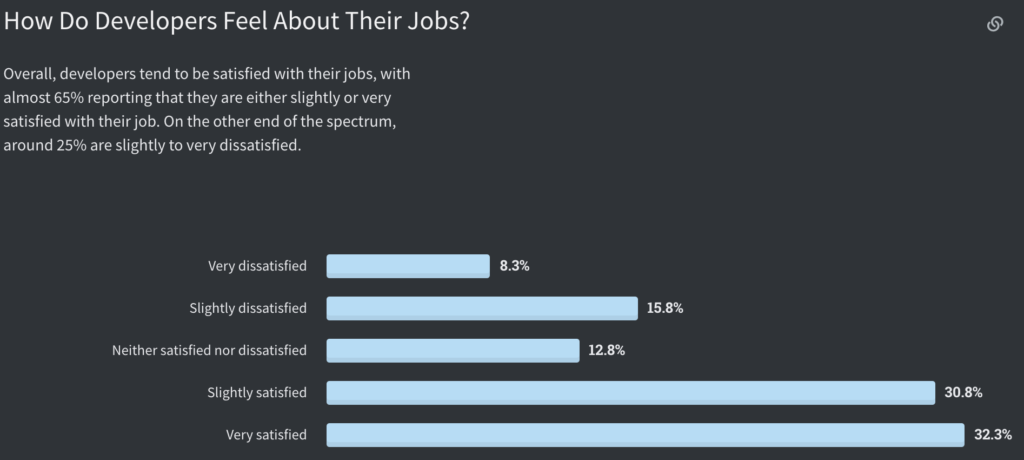
Source: Stack Overflow
Covid-19 impact statistics
- 77% of employees have been working from home since the pandemic emerged. (Robert Half)
- 64.7% of IT professionals are worried about losing their job during the coronavirus pandemic. (CV Library)
- 37% of job seekers have said they were asked for an interview which then could not happen, and 15% have been offered a job that was put on hold or withdrawn because of the pandemic. (CW Jobs)
- In light of the pandemic, the global public cloud IT infrastructure market is predicted to grow to a whopping 120 Billion USD with 35% growth in 2021. (Forrester)
- Almost 60% of people said they would feel confident taking part in a video job interview and think the outcome would be the same as a face-to-face interview. (CW Jobs)
- 74% of professionals would like to work remotely more often than before the outbreak. More parents (79%) expressed this preference. (Robert Half)
- Around 81% of technology startups have stopped or slowed down their hiring. (Computer Weekly)
- 79% of employees believe their employer should have better cleaning strategies. (Robert Half)
- One-third (33%) of respondents report a somewhat increased stress level at work, while nearly one-quarter (22%) report a dramatic increase in stress. Among workers with children at home, 62% reported elevated stress over the past 60 days. (Jobvite)
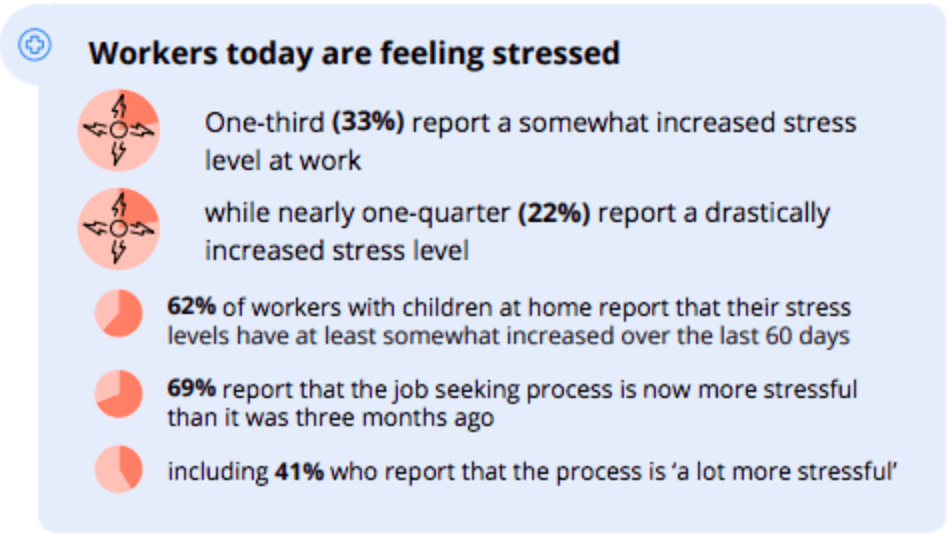
Source: Jobvite
2021 HR Statistics key takeaways
The HR community has undergone massive changes over the past decades and 2020 was no different. The pandemic impacted our lives in a myriad of ways and our workplaces were clearly not spared.
Both business and HR had to find ways to navigate through this crisis and it undoubtedly changed the way we work, communicate, and learn.
A spotlight on mental well-being throughout the crisis and its aftermath will clearly be a great consideration for employers moving forward. As will embracing new technologies as recruitment goes on a more remote path. But the pandemic has also cast silver linings, with recruiters now more acute to the benefits that a diverse workplace can bring to their organization.
It’s worth keeping these HR statistics in mind to keep your company at the forefront of driving these transformations during an uncertain landscape in 2021 and beyond.
Image credit: Pexels
Share post
